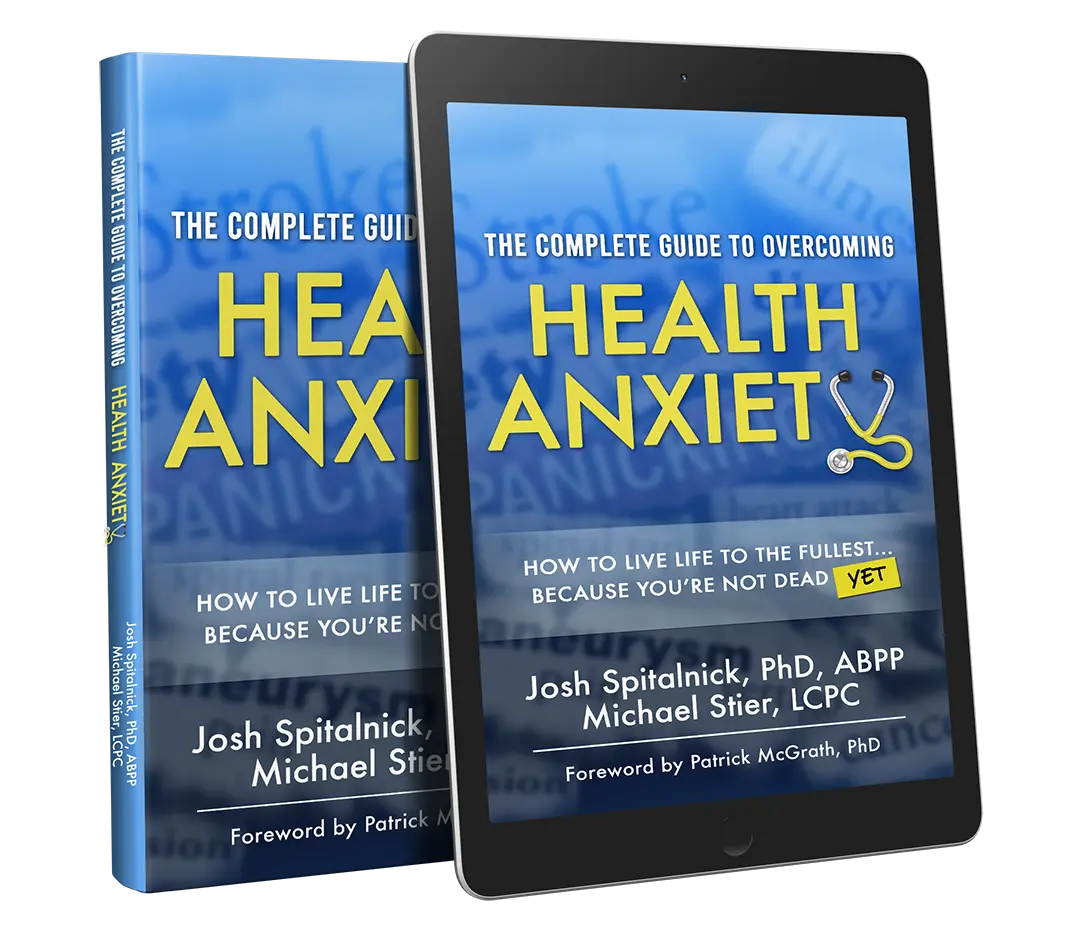If you are in the grips of health anxiety, there is effective treatment that can help you exit the endless loop of worries about your health. Cognitive-behavioral therapy (CBT) is recognized as the most proven treatment approach for overcoming health anxiety, and specifically, CBT with Exposure therapy.
Though CBT includes several treatment approaches that have years of research supporting their use, Exposure therapy continues to be the most researched CBT approach in this clinical area. If you indulge our nerding out for a moment:
- CBT for hypochondriasis/health anxiety outperforms control conditions at post-treatment and follow-up (Cooper et al.,2017; Maasset al.,2020; Olatunji et al., 2014; Thomson & Page, 2007)
- Improvement of patients was greater with CBT than with standard care, waiting list controls, placebo, or psychodynamic therapy (Barsky & Ahern,2004; Bourgault‐Fagnou & Hadjistavropoulos, 2013; Fallon et al., 2017; Sørensen et al.,2011; Tyrer et al., 2017; Weck et al., 2015)
- Various randomized controlled trials (RCTs) have been conducted to prove the efficacy of exposure therapy on patients with hypochondriasis (Roth-Rawald et al., 2022; Weck et al., 2015) including internet delivered CBT-exposure therapy (Hedman et al., 2014)
- Among health anxiety sufferers, CBT can also improve co-occurring conditions like depression, anxiety, and somatic symptoms (Cooper et al., 2017; Maass et al., 2020; Olatunji et al., 2014).
- CBT has also proved its effectiveness even with presence of diagnosed medical diseases when treating health anxiety sufferers (Maass et al., 2020; Olantunji et al., 2014).
In short, CBT and Exposure-based therapies are considered a first-line treatments for health anxiety (and all its other names, like hypochondrias, illness anxiety, and somatic symptom disorder)!
Regardless of the CBT approach, these interventions are structured and evidence-based, aimed at helping individuals overcome excessive worry and preoccupation with their health. These interventions also prioritize eliminating compulsions, rituals, avoidance, and safety behaviors. It is these ineffective coping solutions (i.e., compulsions, rituals, etc) used to combat health anxiety obsessions/doubts that keep anxiety alive and growing! A good way to break this down is remember that obsessions are A problem, while compulsions are THE problem, which is what is targeted in psychotherapy. For more information about the symptoms that are the target of treatment, visit “The Symptoms (TOCs)” page.
Apart from evidence-based psychotherapy, you might consider working with a physician or psychiatrist to find a medication (such as a SSRIs/SNRIs) to be able to help with anxiety symptoms associated with health anxiety, especially if your symptoms are so debilitating that they make it difficult to participate in therapy.
Regardless of the treatment options you consider, undergoing a thorough medical evaluation is important to rule out medical explanations for the experienced symptoms.
How we get stuck in Health Anxiety
To discuss how we can get stuck (and unstuck) from the vicious cycle of health anxiety, it is important for you to know about “danger learning” and “safety learning.” Danger learning occurs when being triggered to a feared stimulus reinforces existing beliefs about the threat, resulting in heightened anxiety and avoidant behaviors. For instance, if you experience a trigger about a medical symptom, and rely on a compulsion to resolve your worries, you have reinforced/trained your brain that there is danger associated with this trigger. Subsequently, this reinforces your perception of the stimulus (e.g., sensation in the body) as dangerous and when the body perceives that it is in a situation that is dangerous, it gives us the emotion that we may all know, but maybe not love: anxiety. For example, flying on an airplane is astronomically safe (1 in 11 billion of something bad happening) and yet we may feel anxious anyways. If you feel anxious and then avoid flying, do you think that teaches your brain danger or safety?
Safety learning involves the gradual realization through our actions that a feared stimulus is not as threatening as initially perceived by repeatedly facing the “safe” triggers that can create anxiety while disengaging from compulsions. When we do this, we are able to send a message to our brain to learn to associate the feared stimulus with safety, leading to a reduction in anxiety and avoidance behaviors. Safety learning often takes a longer period of time, requires variation, and takes more repetition than danger learning, which is often frustrating in therapy but we can be thankful for in other life scenarios. If you find yourself in a bear exhibit at the zoo and somehow are able to escape and not get hurt, we don’t want your brain believing that is a 100% safe scenario!
So what does this mean? When we discuss treatment options below, psychotherapy can help you find ways to be able to face some of the triggers to your health anxiety without engaging in all of the unhelpful mental and behavioral actions that you do to make sure that you are okay (danger learning). Instead, we can learn ways to be able to implement different mental and behavioral actions that can communicate to your brain that it may have less to worry about with your health than it thinks (safety learning).
If you’d like to learn about specific health anxiety treatment services offered by the creators of this site, Dr Josh spitalnick and Michael Stier, LCPC, LPC, and the team they work with, including low cost treatment groups, free support groups, individual therapy, and single session consultations, head on over to our Treatment and Support Services page.
Have other health anxiety questions that you haven’t seen talked about above? Head over to our FAQ section!


